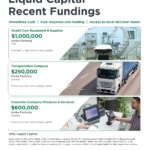How Factoring Can Help You Prepare for and Exploit Seasonal Opportunities
Every seasonal business owner knows the rhythm: The peak season brings massive opportunities, but also massive stress. Your suppliers need payment now, and your staff needs to grow quickly, but your cash reserves are still recovering from the off-season. Just when the market is most ready for your expansion, your working capital hits its lowest point.
It’s one of the most challenging paradoxes in seasonal business: The very nature of your business cycle can keep you trapped in a growth plateau, unable to fully capitalize on your peak season potential.
The Seasonal Growth Plateau
This pattern creates what we call a “seasonal growth plateau” — a frustrating cycle where businesses can clearly see their growth potential but remain trapped by their cash flow limitations. Each year, they have to choose between turning down profitable opportunities or taking dangerous financial risks to seize them.
The consequences extend far beyond just missed seasonal revenue. When businesses can’t fully leverage their peak seasons, they struggle to build the reserves needed for year-round operations. This keeps them perpetually understaffed, under-equipped, and unable to invest in the improvements that could help break the cycle.
Break the Cycle with Strategic Seasonal Factoring
This is where invoice factoring enters the picture — not as an emergency measure, but as a strategic tool for seasonal growth. Think of it less like a fire extinguisher and more like a rocket booster that helps you time your growth with market opportunities.
Consider the story of Ridgeline Manufacturing, a manufacturer of aluminum recreational products. Their summer boat dock business was strong, but the seasonal nature of the industry created significant cash flow challenges. They needed to manufacture and produce products prior to the retail season, which meant giving their dealers enough lead time to stock up. However, standard 90-day payment terms meant their cash would be tied up precisely when they needed it most.
“When manufacturers advance funds to their customers, there is often push-back on us charging interest,” explains owner Nick Newman. “But with factoring, it’s different. As a third party, it’s more palatable to our dealers and helps the collections process too.”
By partnering with Liquid Capital for invoice factoring, Ridgeline was able to:
- Maintain production during off-peak months
- Offer competitive payment terms to dealers
- Keep skilled staff employed year-round
- Build inventory ahead of peak season demand
- Convert seasonal success into sustainable growth
How Strategic Seasonal Factoring Works
Unlike traditional loans that focus on your company’s year-round performance, factoring lets you leverage your strongest season’s receivables to fuel growth. Here’s how it enables seasonal businesses to thrive:
- Flexible capital: Access funds based on your invoices, scaling naturally with your seasonal peaks
- Timing control: Build inventory and staff up when needed, not just when cash flow allows
- Cash flow-friendly terms: Offer competitive payment terms without straining your working capital
- Year-round stability: Convert seasonal success into sustainable operations
When to Consider Seasonal Factoring
Factoring can be particularly powerful for seasonal businesses when:
- You need to build inventory before peak season
- Your suppliers require payment before your seasonal revenue arrives
- You want to maintain quality staff year-round
- Peak season opportunities exceed your current cash flow capacity
Move Beyond Survival Mode
Too many seasonal businesses view factoring as a last resort — a “fire extinguisher” to use only when cash flow hits critical levels. This mindset can trap you in the same seasonal plateau year after year.
Instead, consider factoring as a proactive growth strategy. By having a factoring relationship in place before peak season hits, you’re positioned to say “yes” to opportunities that could transform your business.
“Sure, factoring is higher interest,” notes Newman, “but we build it into the cost of our product and it’s seasonal. So if I pay more than I would with a bank, but can factor for just a few months a year, that’s a big bonus.”
Getting Started
To determine if strategic seasonal factoring could help fuel your growth:
- Map Your Cycle: Document when you need capital vs. when you receive payment
- Calculate Growth Costs: What inventory, staff, and resources would you need to handle more peak-season business?
- Review Terms: Are your current payment terms aligned with seasonal realities?
- Plan Ahead: Don’t wait until peak season – set up factoring relationships during your slower period
Say Goodbye to the Boom-and-Bust Cycle
Seasonal business doesn’t have to mean perpetual cash flow struggles. With strategic factoring, you can break free from the seasonal growth plateau and build a more stable, profitable operation year-round.
By timing your growth financing to match your market opportunities, you can transform seasonal stress into sustainable success. The key is viewing factoring not as an emergency response, but as a strategic tool for seizing the opportunities your peak season presents.






